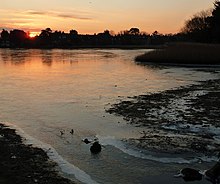
Back حديقة نيو فوريست Arabic حديقة نيو فوريست ARZ Wana Anyar BAN New Forest Catalan New Forest (lasang sa Hiniusang Gingharian, Inglatera, lat 50,87, long -1,58) CEB Fforest Newydd Welsh New Forest Danish New Forest (Landschaft) German New Forest Esperanto New Forest Spanish
| The New Forest National Park | |
|---|---|
IUCN category V (protected landscape/seascape)[1] | |
 Beech trees in Mallard Wood, part of the New Forest | |
 | |
| Nearest city | Southampton |
| Area | 566 km2 (219 sq mi) National Park New Forest: 380 km2 (150 sq mi) |
| Established | 1079 (as Royal Forest), 1 March 2005 (as National Park) |
| Visitors | 14.75 million (est) (in 2009) |
| Governing body | New Forest National Park Authority |
| Website | https://www.newforestnpa.gov.uk/ |
| Geography | |
| Location | Hampshire Wiltshire, England |
| Coordinates | 50°51′47″N 01°37′05″W / 50.86306°N 1.61806°W |
| Official name | The New Forest |
| Designated | 22 September 1993 |
| Reference no. | 622[2] |
| Site of Special Scientific Interest | |
 Beaulieu Mill Pond | |
| Location | Hampshire Wiltshire |
|---|---|
| Grid reference | SU 269 072[3] |
| Interest | Biological Geological |
| Area | 28,924.5 hectares (71,474 acres)[3] |
| Notification | 1996[3] |
| Location map | Magic Map |
| UK National Parks |
|---|
| Parentheses denotes the year. An area with ‡ has similar status to a UK National Park. Areas marked † are proposed. |
The New Forest is one of the largest remaining tracts of unenclosed pasture land, heathland and forest in Southern England, covering southwest Hampshire and southeast Wiltshire. It was proclaimed a royal forest by William the Conqueror, featuring in the Domesday Book.
It is the home of the New Forest Commoners, whose ancient rights of common pasture are still recognised and exercised, enforced by official verderers and agisters. In the 18th century, the New Forest became a source of timber for the Royal Navy. It remains a habitat for many rare birds and mammals.
The boundaries of the forest have varied over time and depend on the purpose of delimiting them.[4] It is a 28,924.5-hectare (71,474-acre) biological and geological Site of Special Scientific Interest.[3][5] Several areas are Geological Conservation Review sites, including Mark Ash Wood,[6] Shepherd’s Gutter,[7] Cranes Moor,[8] Studley Wood,[9] and Wood Green.[10] There are also a number of Nature Conservation Review sites.[11] It is a Special Area of Conservation,[12] a Ramsar site[13][14] and a Special Protection Area.[15][16] Copythorne Common is managed by the Hampshire and Isle of Wight Wildlife Trust,[17] Kingston Great Common is a national nature reserve[18] and New Forest Northern Commons is managed by the National Trust.[19]
- ^ "The IUCN categories". National Parks Portal. Archived from the original on 1 October 2012. Retrieved 28 February 2021.
Even though the IUCN call category II 'National Parks', the UK's National Parks are actually in category V.
- ^ "The New Forest". Ramsar Sites Information Service. Retrieved 25 April 2018.
- ^ a b c d "Designated Sites View: The New Forest". Sites of Special Scientific Interest. Natural England. Retrieved 15 May 2020.
- ^ See, for example, this concerning the National Park boundary: "New Forest National Park". Hansard. 9 January 2001. Retrieved 12 March 2024.
- ^ "Map of The New Forest". Sites of Special Scientific Interest. Natural England. Retrieved 15 May 2020.
- ^ "Mark Ash Wood (Quaternary of South Central England)". Geological Conservation Review. Joint Nature Conservation Committee. Retrieved 21 April 2020.[permanent dead link]
- ^ "Shepherd's Gutter, near Bramshaw (Palaeogene)". Geological Conservation Review. Joint Nature Conservation Committee. Retrieved 21 April 2020.[permanent dead link]
- ^ "Cranes Moor (Quaternary of South Central England)". Geological Conservation Review. Joint Nature Conservation Committee. Retrieved 21 April 2020.[permanent dead link]
- ^ "Studley Wood (Palaeogene)". Geological Conservation Review. Joint Nature Conservation Committee. Retrieved 21 April 2020.[permanent dead link]
- ^ "Wood Green Gravel Pit (Quaternary of South Central England)". Geological Conservation Review. Joint Nature Conservation Committee. Retrieved 21 April 2020.[permanent dead link]
- ^ Ratcliffe, Derek, ed. (1977). A Nature Conservation Review. Vol. 2. Cambridge, UK: Cambridge University Press. pp. 51–52, 120–21, 206–07. ISBN 0521-21403-3.
- ^ "Designated Sites View: New Forest". Special Areas of Conservation. Natural England. Retrieved 24 April 2020.
- ^ "Designated Sites View: Solent and Southampton Water". Ramsar Site. Natural England. Retrieved 23 April 2020.
- ^ "Designated Sites View: The New Forest". Ramsar Site. Natural England. Retrieved 23 April 2020.
- ^ "Designated Sites View: Solent and Southampton Water". Special Protection Areas. Natural England. Retrieved 23 April 2020.
- ^ "Designated Sites View: The New Forest". Special Protection Areas. Natural England. Retrieved 23 April 2020.
- ^ "Copythorne Common". Hampshire and Isle of Wight Wildlife Trust. Retrieved 29 April 2020.
- ^ "Designated Sites View: Kingston Great Common". National Nature Reserves. Natural England. Retrieved 24 April 2020.
- ^ "New Forest Northern Commons". National Trust. Retrieved 24 April 2020.
